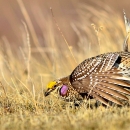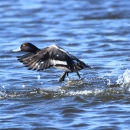About Us
Amazing flights of thousands of waterfowl, shorebirds, and wading birds are visible on the Refuge during spring and fall migration as they rest and feed on Refuge wetlands. During the summer months the grasslands are alive with the songs of bobolinks, western meadowlarks, upland sandpipers, grasshopper sparrows, and other grassland dependent birds. Gadwalls, blue-winged teal, canvasbacks, northern pintails, and many more duck species raise their young on insect-rich diets to get them ready for the long trip south in the fall.
Tewaukon National Wildlife Refuge also provides habitat for wildlife that make the prairie their year-round home. Mink, muskrat, coyote, badger, white tailed deer, garter snakes, leopard frogs, painted turtles, and woodpeckers are some of the hardier species that have adapted and found a way to survive in North Dakota’s harsh climate. Butterflies, beetles, dragonflies and other insects abound in this highly productive habitat providing pollination to a host of native wildflowers and food for a variety of bird species.
Our Mission
Each unit of the National Wildlife Refuge System is established to serve a statutory purpose that targets the conservation of native species dependent on its lands and waters. All activities on those acres are reviewed for compatibility with this statutory purpose.
The mission of the National Wildlife Refuge System is to administer a national network of lands and waters for the conservation, management and, where appropriate, restoration of the fish, wildlife and plant resources and their habitats within the United States for the benefit of present and future generations of Americans.
Our History
The early peoples of the Plains were nomadic hunters and gatherers. Over thousands of years, their seasonal travels would often bring them back to places with an abundance of natural resources. Lake Tewaukon was one of these places.
A Sacred Site
Abundant wildlife found on and near Lake Tewaukon provided seasonal hunting opportunities that drew native people to this area for extended periods of time. While here, people hunted for food and held cultural gatherings and ceremonies. As a vital source of water and a place of great spiritual importance, Lake Tewaukon is today, as it has been for thousands of years, an important part of the cultural heritage for the Native peoples of the region.
TiWakan "Sacred Lodge"
Tribal history recounts that Lake Tewaukon was named for the first leader of the Sisseton Wahpeton Oyate on the Lake Traverse Reservation. TiWakan, which means “Sacred Lodge,” was also known as Gabriel Renville. He was elected head chief for life in 1867 and led his people until his death in 1892.
A Home for His People
In 1867, TiWakan and other tribal delegates signed the Lake Traverse Treaty. The Treaty officially established the general area as a home for the Sisseton-Wahpeton people, who then built permanent houses and farmed the land.
Tewaukon National Wildlife Refuge
On June 26, 1945, Tewaukon National Wildlife Refuge was established as a refuge and breeding ground for migratory birds and other wildlife. In 1946, 512 acres were purchased from local landowners who were interested in preserving the area's natural features and wildlife opportunities. Since that original Refuge purchase, additional lands have been acquired totaling 8,363 acres of wetland and grassland habitat.
A Refuge for All
The National Wildlife Refuge System is the only system of federal lands dedicated specifically to wildlife conservation. Even though wildlife come first on national wildlife refuges, our lives are brighter because them. Even people who’ve never set foot on a refuge arguably benefit from these lands and waters conserved by the U.S. Fish and Wildlife Service. Our Refuges are here to be a living legacy to the majestic natural wonders of our nation.
Other Facilities in this Complex
Tewaukon National Wildlife Refuge is part of the Eastern North Dakota Complex. A National Wildlife Refuge Complex is an administrative grouping of two or more refuges, wetland management districts or other refuge conservation areas that are primarily managed from a central office location. Refuges are grouped into a complex structure structure
Something temporarily or permanently constructed, built, or placed; and constructed of natural or manufactured parts including, but not limited to, a building, shed, cabin, porch, bridge, walkway, stair steps, sign, landing, platform, dock, rack, fence, telecommunication device, antennae, fish cleaning table, satellite dish/mount, or well head.
Learn more about structure because they occur in a similar ecological region, such as a watershed or specific habitat type, and have a related purpose and management needs. Typically, a project leader or complex manager oversees the general management of all refuges within the complex and refuge managers are responsible for operations at specific refuges or wetland management districts. Support staff may include administrative personnel, law enforcement, refuge manager, biological, and fire staff that are centrally located and support all stations within the complex.








